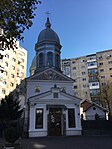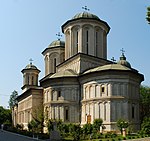Timpuri Noi metro station
1979 establishments in RomaniaBucharest Metro stationsEuropean rapid transit stubsRailway stations opened in 1979Romania transport stubs ... and 1 more
Romanian railway station stubs

Timpuri Noi (New Times in English) is a subway station in Bucharest. The name was taken from the nearby mechanical factory. The factory has since been demolished, making way for a planned office and residential development. The station has yellow, red and white tiling. It was originally the eastern terminus of the M1, being opened on 19 November 1979 as part of the inaugural section of Bucharest Metro, between Semanatoarea and Timpuri Noi. On 28 December 1981, the line was extended east to Republica.
Excerpt from the Wikipedia article Timpuri Noi metro station (License: CC BY-SA 3.0, Authors, Images).Timpuri Noi metro station
Splaiul Unirii, Bucharest Centrul Civic (Sector 4)
Geographical coordinates (GPS) Address Nearby Places Show on map
Geographical coordinates (GPS)
| Latitude | Longitude |
|---|---|
| N 44.41696 ° | E 26.11298 ° |
Address
Acces A Timpuri Noi
Splaiul Unirii
040039 Bucharest, Centrul Civic (Sector 4)
Romania
Open on Google Maps








